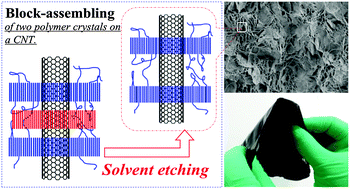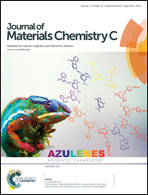Block-assembling: a new strategy for fabricating conductive nanoporous materials from nanocomposites based on a melt-miscible crystalline/crystalline blend and MWCNTs†
Abstract
In this work, we focus on exploring a new method to prepare conductive nanoporous polymeric materials, by simply incorporating multi-walled carbon nanotubes (MWCNTs) into melt-miscible poly(L-lactic acid)/poly(oxymethylene) (PLLA/POM) blends. The POM components in the ternary nanocomposites crystallize first to form “nano-hybrid shish-kebab (NHSK)” structures at a high temperature in the presence of MWCNTs, with the simultaneous exclusion of poorly crystallizable PLLA chains into the intra-NHSK regimes. The subsequent PLLA crystallization in the intra-NHSK regimes is also nucleated on the surface of MWCNTs and transforms the final crystal morphology into “ternary-hybrid shish-kebab (THSK)” superstructures. Therefore, a “binary-polymer-decoration” of MWCNTs, named “block-assembling”, is achieved. Such a novel “block-assembling” structure is further used to fabricate conductive nanoporous polymeric materials with a unique interposition structure of CNTs in the inner wall of the internal pores after the removal of the PLLA components in the ternary nanocomposites.


 Please wait while we load your content...
Please wait while we load your content...